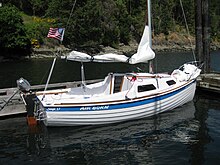| Development | |
|---|---|
| Designer | Jerry Montgomery |
| Location | United States |
| Year | 2011 |
| Builder(s) | Sage Marine |
| Role | Day sailer-cruiser |
| Name | Sage 17 |
| Boat | |
| Displacement | 1,300 lb (590 kg) |
| Draft | 3.50 ft (1.07 m) with centerboard down |
| Hull | |
| Type | monohull |
| Construction | fiberglass and carbon fiber |
| LOA | 16.83 ft (5.13 m) |
| LWL | 15.58 ft (4.75 m) |
| Beam | 6.75 ft (2.06 m) |
| Engine type | outboard motor |
| Hull appendages | |
| Keel/board type | shoal keel and centerboard |
| Ballast | 520 lb (236 kg) |
| Rudder(s) | transom-mounted rudder |
| Rig | |
| Rig type | Bermuda rig |
| Sails | |
| Sailplan | fractional rigged sloop |
| Mainsail area | 98 sq ft (9.1 m) |
| Jib/genoa area | 54–87 sq ft (5.0–8.1 m) |
| [edit on Wikidata] | |

Sage 17 is an American trailerable sailboat that was designed by Jerry Montgomery as a daysailer and a pocket cruiser and first built in 2011.
Production
The design was built by Sage Marine in Golden, Colorado, United States beginning in 2011, and production ceased after being suspended in 2020 due to the COVID-19 pandemic.
Design
Sage 17 is a recreational keelboat, built predominantly of carbon fiber, fiberglass with vinylester resin, with teak wood trim. The deck, coach house and transom have a balsa core.
The sailplan is a 7/8 fractional sloop with a single set of spreaders. The hull has a plumb stem, vertical transom, transom-hung kick-up rudder controlled by a tiller and an underbody with a shoal keel containing a centerboard.
Displacement is 1,300 lb (590 kg) and carries 120 lb (54 kg) of ballast in the centerboard, with an additional 400 lb (181 kg) of ballast in the keel.
Sage 17 has a draft of 3.50 ft (1.07 m) with the centerboard extended and 1.75 ft (0.53 m) retracted, allowing beaching and simplifying transportation on a trailer.
The boat is normally fitted with a two horsepower outboard motor for docking and maneuvering.
The cabin has sleeping accommodation for two people with a double "V"-berth in the cabin. Interior seating is port and starboard just aft of the "V"-berth at the companionway. A head is located under the aft end of the "V"-berth.
The 98 sq ft (9.1 m) main was offered with one or two reef points. Multiple headsails were available:
- 54 sq ft (5.0 m) working jib
- 65 sq ft (6.0 m) 'lapper'
- 87 sq ft (8.1 m) genoa
- 16 sq ft (1.5 m) storm jib.
Roller reefing/furling headsail hardware was an option.
Operational history
Sail magazine named the design one of its Best Boats of 2013, describing it as, "a pretty, seamanlike little thing that’s sure to draw admiring looks way out of proportion to its size."
In Sail magazine's 2013 review Kimball Livingston wrote, "It's easy to like this boat. Anyone looking for a pocket cruiser more or less like this little one should ask for a dance."
See also
References
- "The Sage 17". Sage Marine. Sage Marine. Retrieved 5 May 2024.
- ^ McArthur, Bruce (2020). "Sage 17 sailboat". sailboatdata.com. Archived from the original on 17 August 2021. Retrieved 17 August 2021.
- ^ Sage Marine. "Sage 17". sagemarine.com. Archived from the original on 17 August 2021. Retrieved 17 August 2021.
- McArthur, Bruce (2021). "Sage Marine (USA)". sailboatdata.com. Archived from the original on 17 August 2021. Retrieved 17 August 2021.
- Sage Marine. "Sage Marine". sagemarine.com. Archived from the original on 17 August 2021. Retrieved 17 August 2021.
At this time Sage Marine is in a state of hibernation. We are not building boats at this time.
- Sail Staff (2 August 2017). "SAIL 2013 Best Boats Nominees". sailmagazine.com. Archived from the original on 17 August 2021. Retrieved 15 August 2021.
- Livingston, Kimball (2 August 2017). "Sage 17 Pocket Cruiser". sailmagazine.com. Archived from the original on 17 August 2021. Retrieved 15 August 2021.